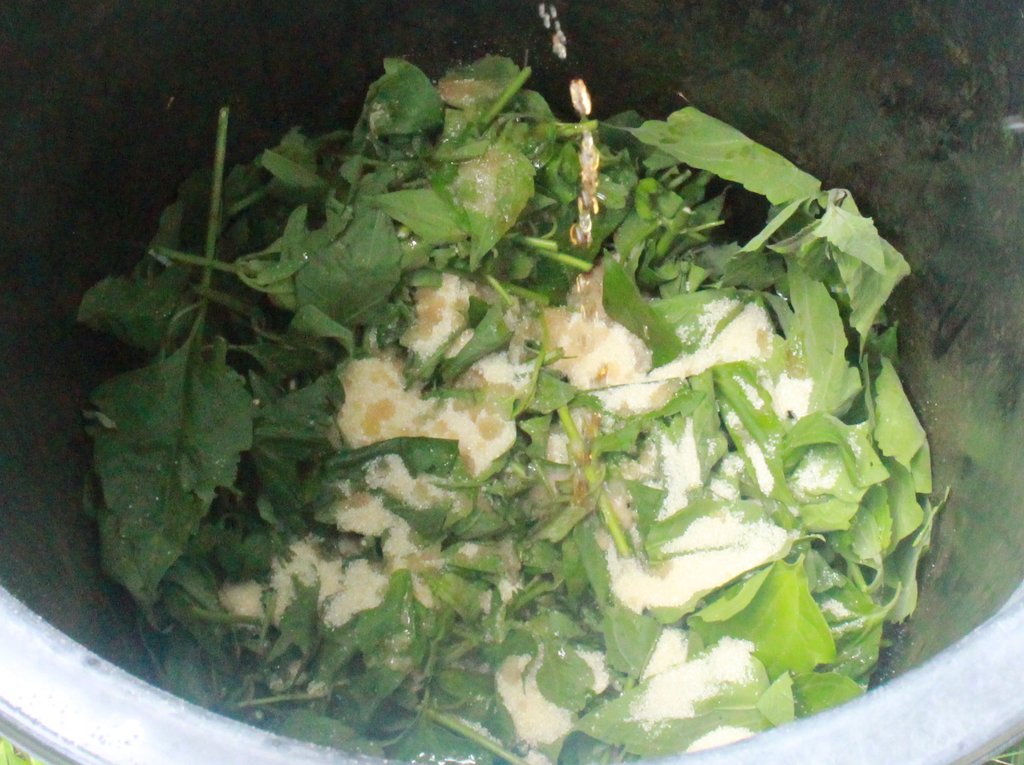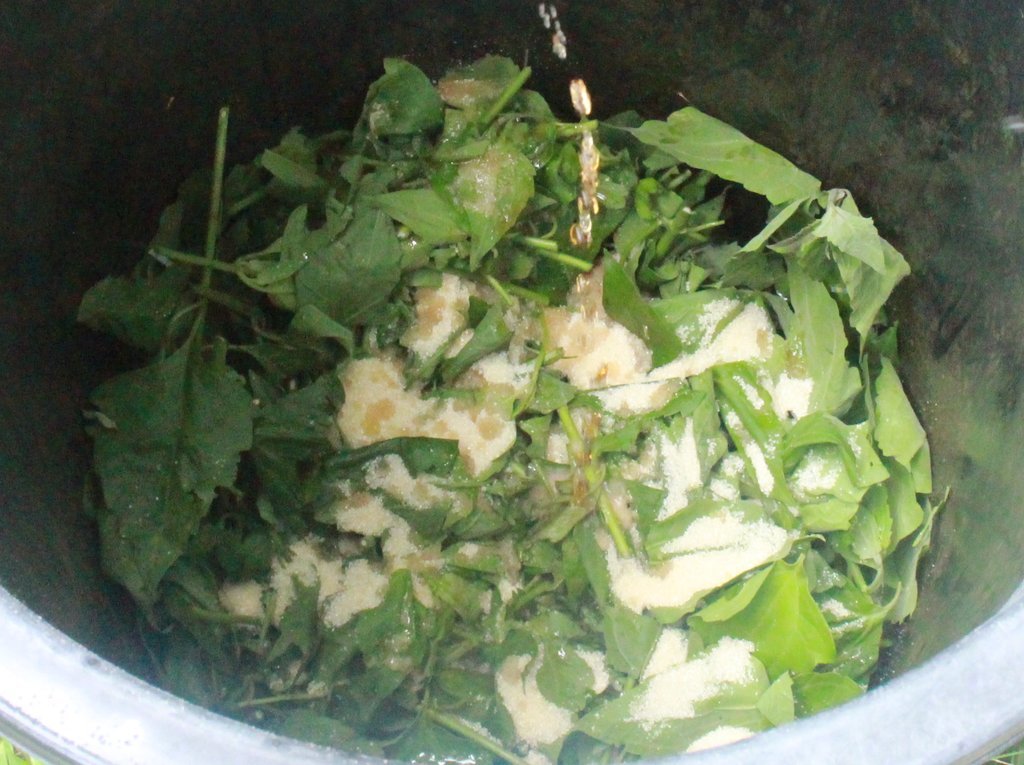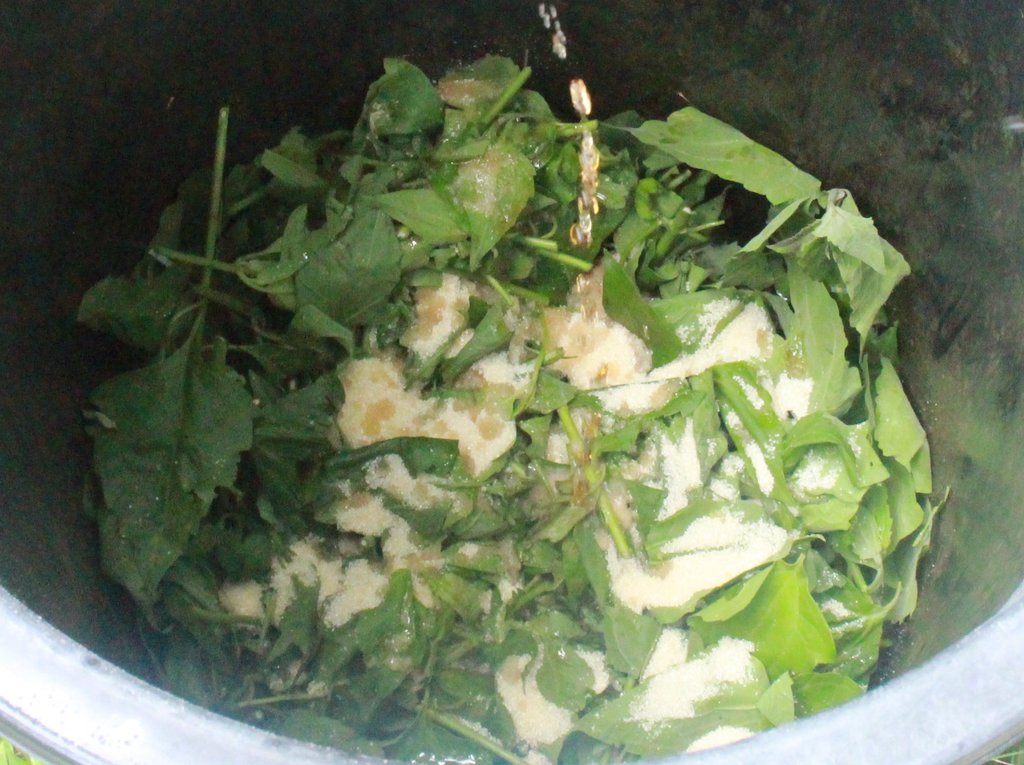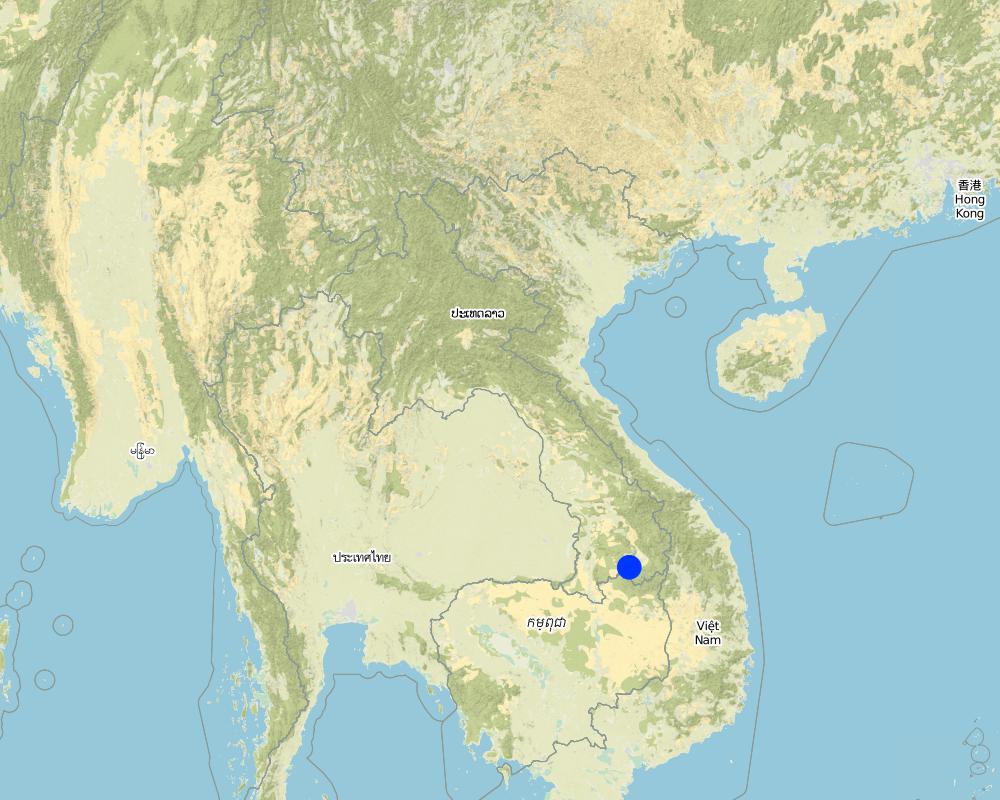Use of Effective Micro-organism (EM) to improve soil fertility in vegetable home gardens [Lao People's Democratic Republic]
- Creation:
- Update:
- Compiler: kang phanvongsa
- Editor: Bounthanom Bouahom
- Reviewers: Nicole Harari, Stephanie Jaquet
technologies_3240 - Lao People's Democratic Republic
View sections
Expand all Collapse all1. General information
1.2 Contact details of resource persons and institutions involved in the assessment and documentation of the Technology
Key resource person(s)
land user:
Sysomphou Khanthavy
0304867035
Agriculture Technical Service Center Phouvong district, Attapue province
Lao People's Democratic Republic
SLM specialist:
Saiyaphone Chanty
030 5184849
District of Agriculture and Forestry Office
Phouvong district of Attapue province
Lao People's Democratic Republic
SLM specialist:
Phaviseth Vixay
020 99596456
District of Agriculture and Forestry Office
Phouvong district of Attapue province
Lao People's Democratic Republic
Name of project which facilitated the documentation/ evaluation of the Technology (if relevant)
Scaling-up SLM practices by smallholder farmers (IFAD) {'additional_translations': {}, 'value': 6128, 'label': 'Name of the institution(s) which facilitated the documentation/ evaluation of the Technology (if relevant)', 'text': "National Agriculture and Forestry Research Institute (NAFRI) - Lao People's Democratic Republic", 'template': 'raw'}1.3 Conditions regarding the use of data documented through WOCAT
When were the data compiled (in the field)?
11/01/2017
The compiler and key resource person(s) accept the conditions regarding the use of data documented through WOCAT:
Yes
1.4 Declaration on sustainability of the described Technology
Is the Technology described here problematic with regard to land degradation, so that it cannot be declared a sustainable land management technology?
No
2. Description of the SLM Technology
2.1 Short description of the Technology
Definition of the Technology:
Effective micro-organism (EM) is a liquid concentrate which can be used as a pre planting treatment, for actively growing vegetables and helps to increase beneficial soil microorganisms and suppression of harmful ones.
2.2 Detailed description of the Technology
Description:
Farmers have practiced household gardening for a considerable period of time in order to increase food security and generate an income. However some farmers have experienced difficulties in cultivating vegetables due to various challenges such as the soil type, for example clay or compacted soil, ineffective water seepage as well as the soil’s low nutrient content making it unsuitable for agricultural purposes. Consequently, the problems that the farmers often faced included vegetables of inferior quality, outbreaks of diseases, as well as surges of insects and pests which typically reduce yields by approximately 30%. In order to increase production and cultivate at a preferable period of time, farmers often applied chemical fertilizer in combination with animal compost. However the production outputs and quality of the produce were not up to expectations if compared to agricultural practices that do not involve the use of chemicals. It has been noted that vegetables grown with the use of chemical fertilizers cannot be kept for a long period of time as they tend to spoil more quickly, despite the increase in production yields. In 2015 an International Fund for Agriculture Development (IFAD) Programme introduced a technique to produce effective micro-organisms (EM) and encouraged people to use these to improve the nutrient content of the soil and thereby enhance the quality of home garden vegetables as well as other potential crops. The farmers gained an interest in EM and began to produce it according to the programme’s instructions. The production of EM is actually relatively easy, and farmers can use organic waste from vegetables such as Chinese mustard (Brassica juncea), morning glory and water spinach mixed with 1kg of sugar and 0.5 kg of molasses (if available, or it can be excluded, but it should be available at an agricultural produce outlet). Firstly the organic waste should be sliced/chopped into small pieces and then sugar and molasses are added which are then all mixed in a 20 litre container. Then a one metre long stick should be used to mix all the ingredients and the container lid should then be sealed properly. Once these steps have been completed, the EM production container should avoid sunlight and be stored in the shade so as to ensure the quality of EM. After one week the container can be opened to mix the ingredients again and then it can continue to remain in the shade for another month. Thereafter, EM mixture is ready for use and one table spoon should be added to 10 litres of water, and once this has been mixed well it can be applied to the vegetables in the home garden by using water cans. Watering involves pouring the solution from the leaves to the stems or to the roots of the vegetables. After the application of the EM solution it was noted that there were more earthworms around the vegetable plots and also that there was an increase in soil moisture and nutrients. Furthermore it was also noted that the soil was previously relatively white and compacted and not black and porous allowing for good water seepage. In this way water is absorbed by the soil in the plot rather than running off over the surface. Plant pathogens and pests/insects such as red ants and leaf worms was reduced. As a result, the vegetables grew well with a good average weight, and there was an increase in both the quality and the yield. As a comparison, in the past farmers used to be able to harvest 5-6 kg per plot, but now they are capable of securing 12-15kg per plot. However, weeds still remain a problem and these include Eleusine indica and thorny grass which compete for nutrients with the crops. It is a challenge for the farmers to control these weeds including other natural vegetables.
2.3 Photos of the Technology
2.5 Country/ region/ locations where the Technology has been applied and which are covered by this assessment
Country:
Lao People's Democratic Republic
Region/ State/ Province:
Attapeu province
Further specification of location:
Phouvong district,
Map
×2.6 Date of implementation
Indicate year of implementation:
2015
If precise year is not known, indicate approximate date:
- less than 10 years ago (recently)
2.7 Introduction of the Technology
Specify how the Technology was introduced:
- through projects/ external interventions
3. Classification of the SLM Technology
3.1 Main purpose(s) of the Technology
- improve production
- reduce, prevent, restore land degradation
- create beneficial economic impact
3.2 Current land use type(s) where the Technology is applied

Cropland
- Annual cropping
Main crops (cash and food crops):
Peppermint, Lettuce, Chinese Kale, Sweet Basil
3.3 Further information about land use
Water supply for the land on which the Technology is applied:
- rainfed
Number of growing seasons per year:
- 2
3.4 SLM group to which the Technology belongs
- integrated soil fertility management
- home gardens
3.5 Spread of the Technology
Specify the spread of the Technology:
- evenly spread over an area
If the Technology is evenly spread over an area, indicate approximate area covered:
- < 0.1 km2 (10 ha)
3.6 SLM measures comprising the Technology

agronomic measures
- A2: Organic matter/ soil fertility
3.7 Main types of land degradation addressed by the Technology

chemical soil deterioration
- Cn: fertility decline and reduced organic matter content (not caused by erosion)

biological degradation
- Bh: loss of habitats
- Bs: quality and species composition/ diversity decline
3.8 Prevention, reduction, or restoration of land degradation
Specify the goal of the Technology with regard to land degradation:
- reduce land degradation
- adapt to land degradation
4. Technical specifications, implementation activities, inputs, and costs
4.1 Technical drawing of the Technology
Author:
Fadavanh Souliya
Date:
11/01/2017
4.2 Technical specifications/ explanations of technical drawing
This bio-extracting technique can be done easily and farmers can use local waste materials such as cabbage, pineapple, spinach and so on. With the following ingredients: 3 kg of vegetables, 1 kg of sugar, 0.5 liters of molasses. Then bring the vegetables to chop thoroughly and then bring the sugar and mixed molasses into a 20 liter tank prepared and mixed together, the area of the bio-extracted technique is 2 meters x 2 meters, Then put about 1 meter of wood to mix it and close the barrel to keep it in the air when practicing all the techniques and then we will bring a bio-extracted tank to a sunny shade to preserve the quality of detergent, Then one more week, we can open the tank for all the ingredients again, so we can do this for a period of time, up to a month, and then add the biological extracts 1 spoon / 10 liters of water to mix and then irrigate the vegetable.
4.3 General information regarding the calculation of inputs and costs
Specify how costs and inputs were calculated:
- per Technology area
other/ national currency (specify):
Kip
Indicate exchange rate from USD to local currency (if relevant): 1 USD =:
8500.0
Indicate average wage cost of hired labour per day:
50000
4.4 Establishment activities
| Activity | Type of measure | Timing | |
|---|---|---|---|
| 1. | Collect the waste vegetable | Agronomic | After harvesting |
| 2. | chop to small size | Other measures | After harvesting |
| 3. | Mix with sugar and molasses | Other measures | |
| 4. | Irrigate vegetable | Other measures |
4.5 Costs and inputs needed for establishment
| Specify input | Unit | Quantity | Costs per Unit | Total costs per input | % of costs borne by land users | |
|---|---|---|---|---|---|---|
| Labour | Labor | person | 1.0 | 50000.0 | 50000.0 | 100.0 |
| Equipment | Knife | peice | 1.0 | 20000.0 | 20000.0 | |
| Equipment | irrigation tank | peice | 1.0 | 30000.0 | 30000.0 | |
| Equipment | Bucket | peice | 2.0 | 25000.0 | 50000.0 | |
| Plant material | Molasses | kg | 1.0 | 8000.0 | 8000.0 | 100.0 |
| Plant material | Sugar | liter | 2.0 | 7000.0 | 14000.0 | 100.0 |
| Total costs for establishment of the Technology | 172000.0 | |||||
If land user bore less than 100% of costs, indicate who covered the remaining costs:
FNML ( Food and Nutrition Market Linkage ) project support an equipment
4.6 Maintenance/ recurrent activities
| Activity | Type of measure | Timing/ frequency | |
|---|---|---|---|
| 1. | Collect the waste vegetable | Agronomic | After harvesting |
| 2. | chop to small size | Other measures | After harvesting |
| 3. | Mix with sugar and molasses | Other measures | |
| 4. | Irrigate vegetable | Other measures |
4.7 Costs and inputs needed for maintenance/ recurrent activities (per year)
| Specify input | Unit | Quantity | Costs per Unit | Total costs per input | % of costs borne by land users | |
|---|---|---|---|---|---|---|
| Labour | Labor | person | 1.0 | 50000.0 | 50000.0 | 100.0 |
| Equipment | Knife | piece | 1.0 | 20000.0 | 20000.0 | |
| Equipment | irrigation tank | piece | 1.0 | 30000.0 | 30000.0 | |
| Equipment | tank | piece | 1.0 | 25000.0 | 25000.0 | |
| Plant material | Molasses | kg | 1.0 | 7000.0 | 7000.0 | 100.0 |
| Plant material | Sugar | liter | 2.0 | 8000.0 | 16000.0 | 100.0 |
| Total costs for maintenance of the Technology | 148000.0 | |||||
If land user bore less than 100% of costs, indicate who covered the remaining costs:
FNML ( Food and Nutrition Market Linkage ) project support an equipment
4.8 Most important factors affecting the costs
Describe the most determinate factors affecting the costs:
Labor
5. Natural and human environment
5.1 Climate
Annual rainfall
- < 250 mm
- 251-500 mm
- 501-750 mm
- 751-1,000 mm
- 1,001-1,500 mm
- 1,501-2,000 mm
- 2,001-3,000 mm
- 3,001-4,000 mm
- > 4,000 mm
Specify average annual rainfall (if known), in mm:
2500.00
Specifications/ comments on rainfall:
Between November and April, rainfall is about 20 - 80 mm
From May to October rain started to fall about 200-500 mm, much rainfall before the first, from June to October.
Indicate the name of the reference meteorological station considered:
Climatology Department of Phouvong District
Agro-climatic zone
- sub-humid
5.2 Topography
Slopes on average:
- flat (0-2%)
- gentle (3-5%)
- moderate (6-10%)
- rolling (11-15%)
- hilly (16-30%)
- steep (31-60%)
- very steep (>60%)
Landforms:
- plateau/plains
- ridges
- mountain slopes
- hill slopes
- footslopes
- valley floors
Altitudinal zone:
- 0-100 m a.s.l.
- 101-500 m a.s.l.
- 501-1,000 m a.s.l.
- 1,001-1,500 m a.s.l.
- 1,501-2,000 m a.s.l.
- 2,001-2,500 m a.s.l.
- 2,501-3,000 m a.s.l.
- 3,001-4,000 m a.s.l.
- > 4,000 m a.s.l.
Indicate if the Technology is specifically applied in:
- not relevant
5.3 Soils
Soil depth on average:
- very shallow (0-20 cm)
- shallow (21-50 cm)
- moderately deep (51-80 cm)
- deep (81-120 cm)
- very deep (> 120 cm)
Soil texture (topsoil):
- coarse/ light (sandy)
Soil texture (> 20 cm below surface):
- fine/ heavy (clay)
Topsoil organic matter:
- low (<1%)
5.4 Water availability and quality
Ground water table:
5-50 m
Availability of surface water:
medium
Water quality (untreated):
good drinking water
Is water salinity a problem?
No
Is flooding of the area occurring?
No
5.5 Biodiversity
Species diversity:
- medium
Habitat diversity:
- medium
5.6 Characteristics of land users applying the Technology
Sedentary or nomadic:
- Sedentary
Market orientation of production system:
- subsistence (self-supply)
- mixed (subsistence/ commercial
Off-farm income:
- less than 10% of all income
Relative level of wealth:
- poor
- average
Individuals or groups:
- individual/ household
Level of mechanization:
- manual work
Gender:
- women
- men
Age of land users:
- youth
- middle-aged
5.7 Average area of land owned or leased by land users applying the Technology
- < 0.5 ha
- 0.5-1 ha
- 1-2 ha
- 2-5 ha
- 5-15 ha
- 15-50 ha
- 50-100 ha
- 100-500 ha
- 500-1,000 ha
- 1,000-10,000 ha
- > 10,000 ha
Is this considered small-, medium- or large-scale (referring to local context)?
- small-scale
5.8 Land ownership, land use rights, and water use rights
Land ownership:
- individual, titled
Land use rights:
- individual
Water use rights:
- individual
5.9 Access to services and infrastructure
health:
- poor
- moderate
- good
education:
- poor
- moderate
- good
technical assistance:
- poor
- moderate
- good
employment (e.g. off-farm):
- poor
- moderate
- good
markets:
- poor
- moderate
- good
energy:
- poor
- moderate
- good
roads and transport:
- poor
- moderate
- good
drinking water and sanitation:
- poor
- moderate
- good
financial services:
- poor
- moderate
- good
6. Impacts and concluding statements
6.1 On-site impacts the Technology has shown
Socio-economic impacts
Production
crop production
Quantity before SLM:
5-6 kg/plot of vegetables
Quantity after SLM:
Increased 12-15 kg/plot of vegetables
crop quality
Comments/ specify:
Strong and sound plants. Due to reduced plant pathogens and pests/insects such as red ants and leaf worms.
product diversity
Comments/ specify:
Increase and diversity of different type of vegetables for home consumption and selling.
Income and costs
farm income
Comments/ specify:
Increased income from selling vegetables
Ecological impacts
Water cycle/ runoff
surface runoff
Comments/ specify:
Water is absorbed by the soil in the plot rather than running off over the surface.
Soil
soil crusting/ sealing
Comments/ specify:
soil was previously relatively white and compacted and now it is black and porous allowing for good water seepage
Biodiversity: vegetation, animals
beneficial species
Comments/ specify:
More earthworms
6.3 Exposure and sensitivity of the Technology to gradual climate change and climate-related extremes/ disasters (as perceived by land users)
Gradual climate change
Gradual climate change
| Season | Type of climatic change/ extreme | How does the Technology cope with it? | |
|---|---|---|---|
| annual temperature | increase | moderately | |
| seasonal temperature | dry season | increase | moderately |
| annual rainfall | decrease | not well | |
| seasonal rainfall | wet/ rainy season | decrease | moderately |
Climate-related extremes (disasters)
Meteorological disasters
| How does the Technology cope with it? | |
|---|---|
| local rainstorm | moderately |
| local windstorm | not well |
Climatological disasters
| How does the Technology cope with it? | |
|---|---|
| drought | well |
Biological disasters
| How does the Technology cope with it? | |
|---|---|
| insect/ worm infestation | well |
Other climate-related consequences
Other climate-related consequences
| How does the Technology cope with it? | |
|---|---|
| extended growing period | not well |
6.4 Cost-benefit analysis
How do the benefits compare with the establishment costs (from land users’ perspective)?
Short-term returns:
positive
Long-term returns:
very positive
How do the benefits compare with the maintenance/ recurrent costs (from land users' perspective)?
Short-term returns:
positive
Long-term returns:
very positive
6.5 Adoption of the Technology
- 10-50%
Of all those who have adopted the Technology, how many have did so spontaneously, i.e. without receiving any material incentives/ payments?
- 90-100%
6.6 Adaptation
Has the Technology been modified recently to adapt to changing conditions?
Yes
If yes, indicate to which changing conditions it was adapted:
- changing markets
6.7 Strengths/ advantages/ opportunities of the Technology
| Strengths/ advantages/ opportunities in the land user’s view |
|---|
| Easy to find the vegetable waste and not complicate process. |
| Reduces household expenses for input cost as the cost of producing of EM is cheaper than buy chemical fertilizer |
| Increased household income from vegetables and improved food security |
| Strengths/ advantages/ opportunities in the compiler’s or other key resource person’s view |
|---|
| Environmentally friendly and good for land user's health. |
| Increased both quantity and quality of vegetable production. |
6.8 Weaknesses/ disadvantages/ risks of the Technology and ways of overcoming them
| Weaknesses/ disadvantages/ risks in the land user’s view | How can they be overcome? |
|---|---|
| EM solution also encourages more grass/weeds to grow especially leusine indica and thorny grass that challenge for farmers to control weed. | |
| Sometimes, it is difficult to find molasses in general grocery |
7. References and links
7.1 Methods/ sources of information
- field visits, field surveys
1
- interviews with land users
2
7.3 Links to relevant information which is available online
Title/ description:
ນຳ້ຳສະກັດຊີວະພາບ (ປຸຍນຳ້ຳ), ສພກສຍ (SEADA)
URL:
http://lao44.org/content/1652
Links and modules
Expand all Collapse allLinks
No links
Modules
No modules






